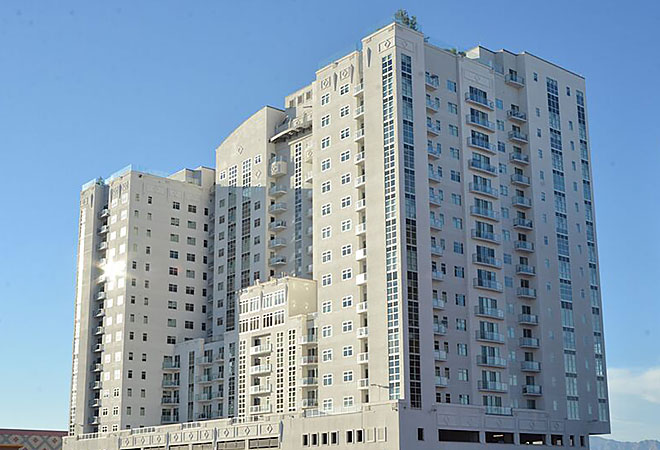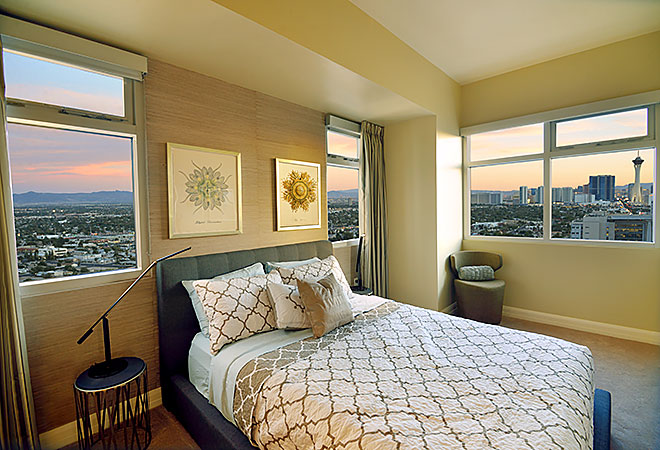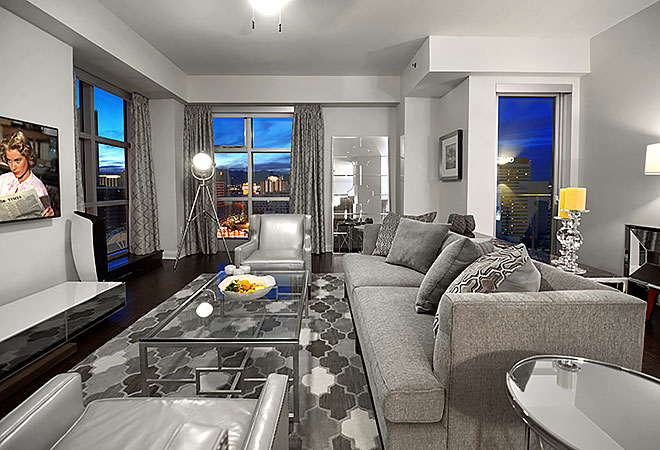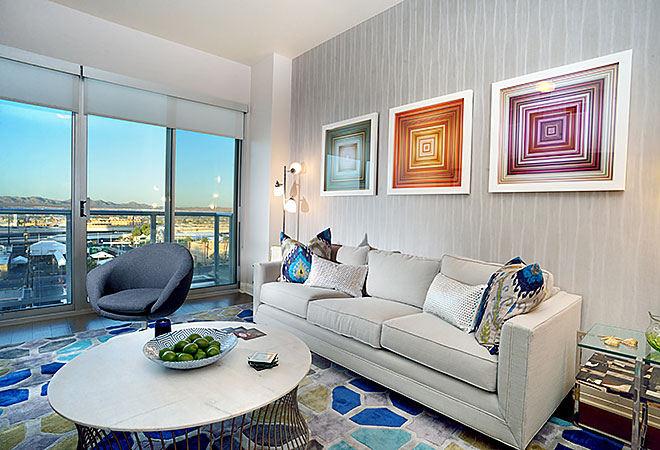An Urbane Man
Urbanization is an upward trend, literally, in many metropolitan housing markets – Las Vegas prime among them. The allure of vibrant city living, with fingertip access to culture, entertainment, sporting events, shopping and fine dining, is increasingly attractive to a spectrum of home buyers, including aging baby boomers, up-and-coming hipsters and globetrotting jet-setters.
While some are still opting for the private communities of luxury single-family homes found throughout Las Vegas, it’s the high-rise condo explosion that’s making news.
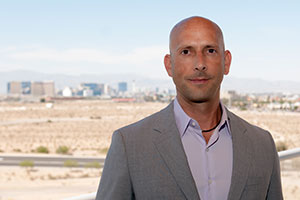
Uri Vaknin
In 2013, Uri Vaknin, a partner in KRE Capital LLC – a private equity firm in Beverly Hills – joined forces with Dune Real Estate Partners in New York, and Las Vegas-based Northcap, to buy five Las Vegas condominium properties – the Ogden and Juhl (downtown properties), Loft 5, One LV and Spanish Palms, a residential garden complex.
Those properties comprise 1,300 units valued at more than $400 million. Vaknin, CEO of DK Las Vegas, the joint ownership entity, is betting the valley is ready again to convert rentals to condominium ownership.
Downtown luxury high-rises built between 2005 and 2009 have been on an economic roller coaster. At one point condos were fetching more than $1 million, and were being sold from blueprints. But when the valley’s real estate market tanked, prices dropped below construction costs.
Buyers fled; sales evaporated; foreclosures mounted. Landlords had to rent units, leaving buildings with a blend of tenants, owners, homeowner associations and on-site leasing agents.
Eventually, the federal government and private investors stepped in, rented the units designed as for-sale condos and sold the buildings in bulk.
Today’s market looks primed for recovery. Vaknin is confident his group’s portfolio will yield big profits and contribute to a substantial turn-around in downtown Las Vegas over the next five years, due to multi-tiered gentrification.
“Our initial focus is selling condos in the 21-story, 273-unit Ogden, the most prominent property in the portfolio. We spent over $1.5 million on capital improvements and upgrades before recently returning the building to market,” he says.
Improvements include: overhauling the lobby with glass bead wallpaper, silver-embossed leather backrests and navy blue mohair-covered seating; a sky deck with shade structure capable of withstanding 120 mph winds; a cooking area with grill and wine cooler; comfortable lounge chairs set in a desert landscape; a renovated outdoor pool; club room; fitness center; and new lighting, hardwood floors, stainless steel appliances and granite countertops in all units.
“We want interested buyers to experience a sense of arrival,” Vaknin says. “At the same time we wanted to maintain the hip funkiness of the building that was originally called the Streamline Towers back in 2008.”
Equally important, says Vaknin, are ground-floor amenities (two restaurants and a bar at the Ogden) that add convenience and vitality to the neighborhood.
The ground floor at the Juhl — it’s near the Bonneville Transit Center — soon will be home to seven retailers, including a coffee shop, a furniture store, mixology lounge, waxing studio and a well-known eatery. Health food purveyor Greens & Proteins is scheduled to take a space nearby.
“None of these by themselves represent game-changers,” says Vaknin. “But collectively they make for a community environment with hipster-friendly businesses, in a walkable area.”
“We highly curate who is going to occupy these ground-floor spaces. They have to be both an amenity to the building and to the downtown,” he adds.
The group plans to gradually sell units – Vaknin refers to them as homes — in the remaining four buildings over the next few years. “We want to avoid flooding the market,” he says.
Fifteen percent of the homes at the Ogden, 150 Las Vegas Blvd. N., are individually owned now, with the rest rented. Residents include Zappos CEO Tony Hsieh, who leased several units and is known for putting up visitors and tech startups in the building.
“We’re not renewing leases as they come due in order to prepare more homes for sale,” Vaknin says. He’s quick to note, however, that tenants can opt to buy their units before they go to market, and KRE will honor all leases, and in some instances extend them. “We want to be considerate of both the renter and the owner in this venture,” he says.
About 15 units become available at the Ogden each month, and Vaknin has two national lenders on site to provide financing for qualified homebuyers.
According to the National Association of Realtors, Las Vegas is experiencing a real estate, population and culture boom. And though the city is known historically for gambling, with little in the way of downtown housing, an influx of high-end and sophisticated homebuyers is fueling the need for options and diversions.
“A lot is happening downtown,” Vaknin says. “You have the Smith Center, the Discovery Children’s Museum, Symphony Park, Container Park, Fremont Street, the new City Hall, Zappos, the Arts District … restaurants … bars … concert series. Life is Beautiful is at our doorstep! Most of the law offices and courthouses are already here; and increasingly businesses are moving in. This all makes for a diverse and interesting mix of people, and the need for housing for those who want to live near their work and feel the energy of a downtown lifestyle.”
Vaknin’s on a board exploring options to open a first class art museum in the downtown area, which he says will enhance the city’s cultural dimension.
In a 2011 National Association of Realtors poll, 19 percent of Americans wanted to live in a city, up from 13 percent in 2004. Many cities have become safer and cleaner. Empty-nest baby boomers no longer worry about the quality of schools; nor do they want the cost or burden of large home maintenance, says John McIlwain, a former senior fellow at the Urban Land Institute in Washington, D.C.
“They also want to return to their former, youthful days when they lived, worked and played in a city environment,” McIlwain says.
Bruce Weiner, former CEO of Turnberry Ltd., which owns three complexes in the city, knows just where folks born between 1946 and 1964 can find that pulsating environment they’re after.
“If you like entertainment, Las Vegas is the entertainment capital of the world. If you like gaming, it doesn’t get much better than Las Vegas,” Weiner says. “If you like shopping, it’s world-class shopping. Dining … every celebrity chef from America and other parts of the world has opened up restaurants here.”
Vaknin says he and his colleagues initially believed “our market would largely be young hipsters. We were surprised to find that, in fact, there has been great interest from the 55-and-older set. They’re tired of mowing the lawn and want to be in a more youthful and accommodating setting.”
A 56-year-old corporate executive who swapped her 3,500-square-foot home in Henderson for an 850-square-foot condo downtown says, “You’re as young as you feel. I replaced my old furniture with more modern pieces, and I now easily take advantage of walking to fabulous restaurants and shops anytime of the day and night. And the city views are like none other!”
Retired physician James Wyler and his wife also went urban, purchasing a downtown condo. “We want to be around people who are younger,” he says, “because that gives us more energy. Many of our friends have chosen the 55-plus communities on golf courses, forgoing ethnic diversity and outside opinions.”
The Wylers say they’re part of a multigenerational book club in their new building. “We find people here are much more engaged in the world,” James says. “Every day we say, ‘Can you believe this? This is so fun.’”
Glenn Coffman, a downtown condo denizen, considers himself part of a new generation of hipster. He’s married with a baby and has started hanging out with some of the boomers who’ve moved the neighborhood. “If you told me I’d one day become friends with people near to my parents’ age(s), I would have said, ‘No way!’” he says.
Vaknin says the Spanish Trails-adjacent Spanish Palms Condominiums will be the next of the five buildings to offer homes for sale, once ground renovations including athletic, pet and garden amenities are added.
Las Vegas is certainly a unique U.S. city, but it shares one thing with other towns: Beginning with the post-war economic boom, people decamped to the suburbs, taking with them the social and economic vitality that once marked urban centers.
Downtown Las Vegas was the epicenter of the valley until the 1960s. But with the advent of the Strip, and the suburban explosion, downtown Las Vegas became an afterthought. Master-planned communities in safe areas, amid pleasant surroundings, defined “progress,” at the expense of downtown.
City leaders who saw tourists flocking to the Strip sought ways to keep customers downtown. The Fremont Street experience represented an attempt to do that, but it didn’t attract new residents, jobs or businesses to the city center.
Scott Adams is acting deputy city manager for the city of Las Vegas. He believes downtown redevelopment is synonymous with economic development. “It’s not just about elimination of slums and blight,” he says. “It really is at its very foundation rebuilding the core of a city and its economy.”
Former Mayor Oscar Goodman implemented initiatives to address this. Hsieh and his investors are following suit with the Downtown Project. They’ve set aside $200 million for real estate development, and $50 million to aid small businesses, technology startups and education.
“It’s a work very much in progress,” says Vaknin, adding that DK Las Vegas is happy to help bring the American dream back to downtown Las Vegas through real estate development and home ownership.

